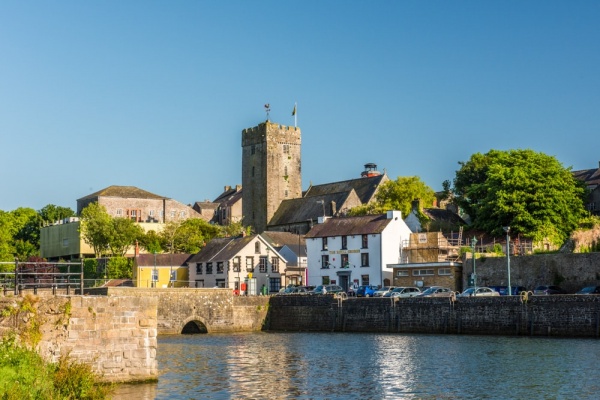
The historic town of Pembroke is one of the most compelling places to visit in Wales, a place where history is ever-present. Most people come to visit the medieval fortress of Pembroke Castle, the birthplace of a king and the site of several dramatic sieges, but there is so much more to see in this delightful town.
History
The story of Pembroke begins in the mists of prehistoric Britain when early settlers sheltered in a large cave beneath what is now Pembroke. The Romans later occupied the site, but it was not until the Norman invasion of Wales in the late 11th century that the town of Pembroke began to take shape.
When Rhys ap Tewdwr, ruler of South Wales, died in 1093 the Norman lord Roger de Montgomery, Earl of Shrewsbury, quickly launched an invasion. As soon as he took control of Pembroke Roger began building a castle to control his new territory. Roger's son Arnulf rebelled against Henry I and the English king immediately seized Pembroke and its castle.
Henry I established a royal borough, a planned settlement, outside the castle walls, and invited settlers from England and Flanders to inhabit the new borough. To emphasise the importance of the new town Henry also established a royal mint in Pembroke. The growing town served as the centre for the English-occupied part of southern Wales known as 'little England beyond Wales'.
The medieval layout of the planned town is still evident today; the town is centred on a long High Street, with narrow burgage plots stretching out away from the street, with the whole contained within high town walls protected by towers.
King Stephen gave Pembroke to Gilbert de Clare and named him the first Earl of Pembroke. Gilbert's son Richard incurred Henry's anger and the king seized Pembroke, only to relent and give it back, but when Richard died without a male heir the king took his daughter Isabel and royal ward.
Henry wanted a loyal supporter, a man he could trust, to hold Pembroke and its castle, so he turned to William Marshall, one of the foremost knights of medieval Europe. He named Marshall the new Earl of Pembroke and gave him Isabel in marriage. William Marshall, aided by Isabel de Clare's sizeable fortune, transformed Pembroke Castle into one of the most impressive medieval fortresses in Britain.
Marshall's sons proved ineffective rulers, and the townsfolk of Pembroke were forced to pay a large fee of £100 to ensure that Llewelyn the Great did not sack the town or castle in 1220.
The Earls of Pembroke helped forge the town's prosperity, taking advantage of Pembroke's location on the Pembroke River to make it a centre for trade along the south coast and across the Bristol Channel to England.
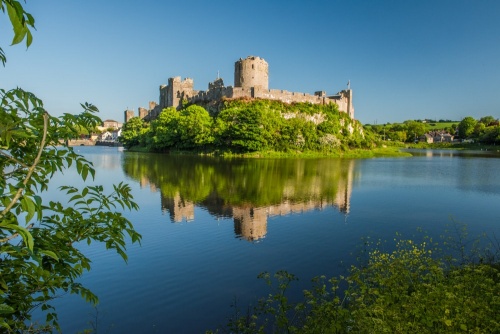
Birthplace of a King
Pembroke Castle did see action in 1405 when a French army supporting Owain Glyndwr's rebellion besieged the castle. In 1457 Henry Tudor was born at Pembroke Castle to Margaret Beaufort, then aged just 13. Margaret was the widow of Edmund Tudor and had come to Pembroke under the protection of Jasper Tudor, her brother-in-law and Earl of Pembroke. Henry Tudor would grow to become Henry VII and found the Tudor dynasty.
The castle diminished in importance during the 16th century, but it was the site of high drama during the Civil War. The town supported Parliament during the conflict, and the mayor of Pembroke, John Poyer, rebuilt the castle's crumbling defences. After the war, Poyer made himself an enemy of Oliver Cromwell when he supported Parliamentary soldiers complaining of not being paid (another version of events simply says that Poyer first declared for Parliament then changed sides to support the King).
Either way, Cromwell was irate, and personally took command of Parliamentary troops that besieged the town. After a siege lasting two months, the inhabitants were forced to surrender.
Cromwell wanted to ensure that the town and castle could not be held against him again, so large sections of the town walls were pulled down and the castle was 'slighted' so it would never have military importance in future. As for Poyer, he and his supporters were promptly executed.
The castle was left a romantic ruin, a destination for artists drawn to paint the crumbling walls. Despite the castle's misfortune, Pembroke itself recovered and became a prosperous town described by author Daniel Defoe as 'the largest, richest, and at this time the most flourishing town in all of south Wales'.
The castle was saved from decay in the mid 20th century when Sir Ivor Philipps restored the medieval walls and helped bring back some of its former splendour. Today the castle is among the most popular historical attractions in Wales, the destination of tourists from across the globe.
As wonderful as the castle is to see, there is much more to Pembroke.
To make the most of a visit to Pembroke I highly recommend picking up a copy of the Pembroke Town Trail, a very handy map detailing the major historic sites. The Trail leaflet is available at the castle, the TIC, the Town Hall, and many other outlets around the town.
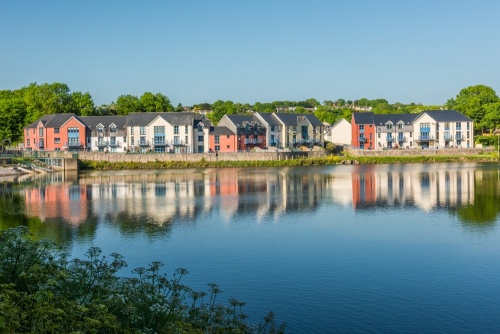
Pembroke Town Trail
Town Hall
What better place to start the trail that at Pembroke's historic Town Hall, easily spotted by its striking clock tower that quite literally towers over the shops along Main Street. The Town Hall was built in 1820 and was originally open at ground level to provide a space for market stalls, with a council chamber on the first floor. The Town Hall interior is decorated with large murals depicting the history of Pembroke. On the first floor is the Pembroke Museum, where you can learn about the long history of this delightful town.
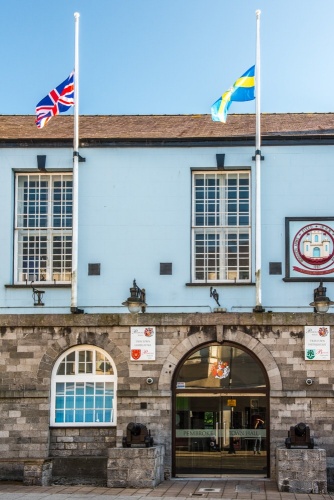
Opposite the Town Hall is Clock House, originally the site of an open market. The market was enclosed when the striking tower was restored in the late Victorian period. Look for two lead cherubs on the clock tower. There were originally four of these naked imps, one on each corner. Unfortunately, two of them faced the nearby churchyard, and church authorities objected, so the cherubs were removed.
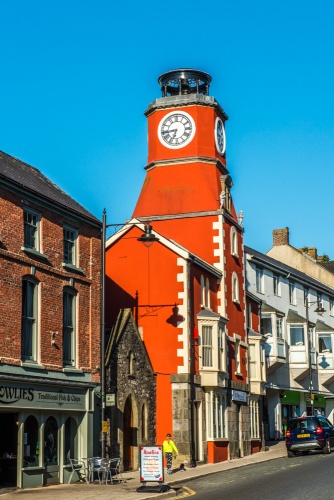
St Mary's Church
One of three medieval churches in Pembroke, St Mary's dates to the late 12th century. More recent are wonderful Victorian stained glass windows by CE Kempe, depicting famous events and people in Pembroke's history. By the entrance is a Tudor bench commemorating the birth of Henry VII (Henry Tudor) at the nearby castle in 1457.
Nearby is the NatWest bank, a former 18th-century coaching inn named the Green Dragon. Look for the high arch made to allow coaches through to the stable yard. Beside the bank is a Georgian house named McClarens, still boasting its original Georgian bow window.
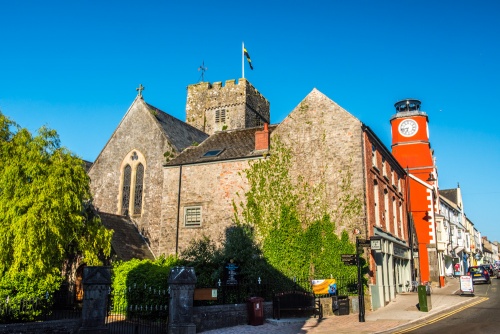
Poyer's House
The home of John Poyer, mayor of Pembroke during the Civil War. The house is presently home to an estate agent firm. Beside Poyer's House is Brown's Fish and Chips, one of the oldest businesses in Pembroke. The chippie was run by Connie Brown and her husband Sid for decades and became such a fixture that Connie was awarded a CBE and served fish and chips until the ripe old age of 102.
Orielton Terrace
Opposite the chip shop is Orielton Terrace (also known as Chain Back). In the centre of this row of attractive houses is Orielton House, once the home of the Owens family who owned much of Pembroke. several family members served as MPs for the area. In front of the houses at ground level is an old milepost and one of the town's original public water taps.
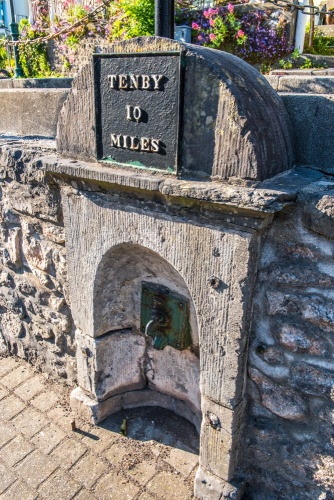
National School
This striking little school building was established in 1861 by the National Society for Promoting the Education of the Poor in the Principle of the established Church. Thankfully the schools were shortened to be called simply 'National School'. Across the road is Elm Tree Square, once home to the town gallows.
Old Cross Saws Inn
On Main Street is this attractive old pub, named after a preaching cross that once stood here. Beside the inn are a trio of Georgian houses. Of these, Number 111 has been called 'the crowning glory of Pembroke's domestic architecture'. Look for the old vending machine selling stamps and pre-stamped postcards.
St Michael's Church
The second of Pembroke's medieval churches, St Michael's was built in the Norman period, rebuilt in 1835, and rebuilt again in 1887. Unfortunately, the church was forced to close in 2013 and is now redundant. also redundant, but very much in use, is the striking Wesleyan Chapel, an eye-catching Victorian building in Italianate style. It is now an antique centre. The chapel was built in memory of John Wesley, founder of Methodism, who made numerous visits to Pembroke.
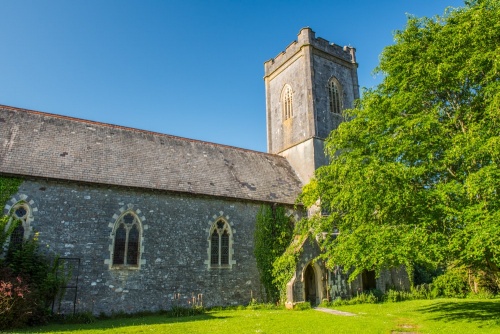
East Back
Parallel to Main Street is East Back, where you can see the town's first public water tap standing near the Mount Pleasant Baptist Chapel (also redundant).
The Commons
Originally a marsh, the wet ground of this area defended the approach to the southern part of Pembroke's town walls. The Commons was home to businesses not welcome ion the centre of town, including a slaughterhouse, tannery, and iron works. Thankfully the area is no longer so unwelcoming! Look for Orange Gardens, an early 19th-century development built to house workers on the Royal Dockyard at Pembroke Dock.
The Town Walls
The best place to see the medieval town walls of Pembroke is on Common Road. Here you can also see the ruins of lime kilns, used to process lime for fertilizer and mortar. Built into the town walls is the Gun Tower (also known as the Defending Tower). This was one of six flanking towers that gave defenders a good view along the line of the wall.
Nearby on Rock Terrace is another of the towers, dubbed 'The Gazebo' for a Victorian-era summerhouse built on top of the medieval base.
Goose's Lane follows the line of the medieval walls. Its name comes from the fact that geese were herded through the area on their way to The Common for livestock fairs.
East End Square
The site of the medieval East Hate, which occupied the site where the Royal Oak pub now stands. The gate was destroyed by Cromwell after the siege of 1648. Look for St Michael's Hall, which formed part of a school established in 1873.
Barnard's Tower
The most striking tower to survive from the medieval town defences, Barnard's Tower dates to the 13th century and stood in the north-east corner of the town wall. The tower was large enough to accommodate a garrison of soldiers. It looks out over the Millpond, once a tidal inlet, later dammed to feed a corn mill. Millpond Walk runs beside the peaceful waterway as it follows the north section of the town walls.
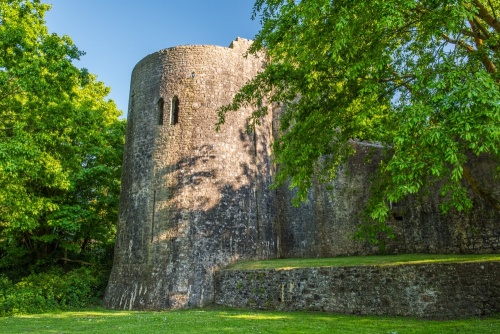
Golden Farm & Olds Workhouse
On the far bank of Mill Pond is The Old Workhouse, established in 1839 as the Pembroke Union Workhouse. Beside it is Golden Farm, a former prison used to hold French soldiers captured in the invasion of Fishguard in 1797 - the last invasion of mainland Britain. Five hundred French prisoners were incarcerated at Golden Hill prison.
A pair of young local women were employed to carry food to the prisoners and carry away refuse. The women fell in love with a pair of French soldiers. The soldiers dug a tunnel under the prison walls and were aided by the women to seize a yacht belonging to Lord Cawdor in the harbour and make good their escape. The couples married and at least one of them returned to Pembroke after the war with France was over.
Awkward Hill & Monkton Old Hall
West of the castle the Town Trail climbs Bridgend Terrace to Monkton. On the right is the beautifully named Awkward Hill. At the bottom of Awkward Hill is Monkton Old Hall, built in the 14th century, though it seems that the vaulted cellars are much earlier than that. The Hall was used as a medieval guesthouse for Monkton Priory and is thought to be one of the oldest domestic buildings in Wales. The Hall is owned by the Landmark Trust who rent it out as holiday accommodation.
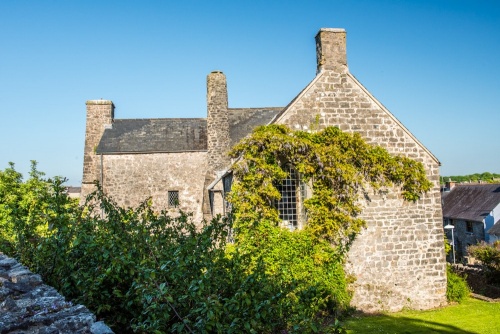
Priory Church
At the top of Awkward Hill is the Priory Church of St Nicholas & St John, the oldest church in Pembroke. The church formed part of an 11th-century Benedictine priory but was built on a much earlier Christian site. The priory was suppressed by Henry VIII, but the church survived to serve the people of Pembroke. Oliver Cromwell set up his cannon in the churchyard during the 1648 Siege of Pembroke.
From the churchyard, you can see freestanding arches and a gable wall - all that remains of the medieval priory, now on private land and unfortunately inaccessible. The neighbouring farmhouse probably dates to the 14th century and probably served as the prior's lodging. In the nearby field is a medieval dovecote used by the monks to provide much-needed meat during the winter months.
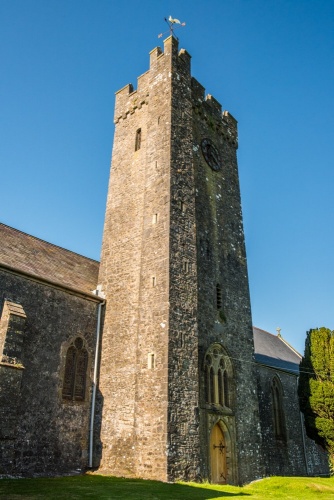
Westgate Hill
On Westgate Hill, opposite the castle, stood the medieval West Gate to Pembroke. You can still see the supports for the gateway arch, which stretched over the road to the castle. Beside the tower arch are a row of medieval cottages, some of the oldest buildings in Pembroke.
The Lion & Old King's Arms
Near the Town Hall is the last stop on the Town Trail, the Lion and Old King's Arms pubs. The two pubs began as 18th-century coaching inns. The Lion was a stopover post for the Royal Mail Coach. The Lion was built by the Owen family of Orielton, mentioned earlier. The pub sign was a gilded lion, the family's heraldic symbol.
Visiting
Pembroke is an absolute delight to visit. By far the best way to enjoy the town and really get a sense of its history is to follow the town trail, but even if you just want to visit the castle it is well worth a visit. The best place we have found to park is in the large parking area on Common Road, at its junction with Park Street. This has the advantage of being very close to the library and tourist information centre on the north side of the road.
About Pembroke
Address: A4139,
Pembroke,
Pembrokeshire,
Wales
Attraction Type: Town
Location: On the A4139, three miles south-east of Pembroke Dock
Website: Pembroke
Location map
OS: SM989012
Photo Credit: David Ross and Britain Express
HERITAGE
 We've 'tagged' this attraction information to help you find related historic attractions and learn more about major time periods mentioned.
We've 'tagged' this attraction information to help you find related historic attractions and learn more about major time periods mentioned.
Find other attractions tagged with:
NEARBY HISTORIC ATTRACTIONS
Heritage Rated from 1- 5 (low to exceptional) on historic interest
Barnard's Tower, Pembroke - 0.1 miles (Historic Building) ![]()
Pembroke Castle - 0.5 miles (Castle) ![]()
Lamphey Bishop's Palace - 1.8 miles (Historic Building) ![]()
St Petrox Church - 2.7 miles (Historic Church) ![]()
Upton Castle Gardens - 2.7 miles (Garden) ![]()
Upton Castle Chapel - 2.9 miles (Historic Church) ![]()
Stackpole, St James and St Elidyr Church - 3.1 miles (Historic Church) ![]()
Stackpole Court & Walled Gardens - 3.2 miles (Garden) ![]()



